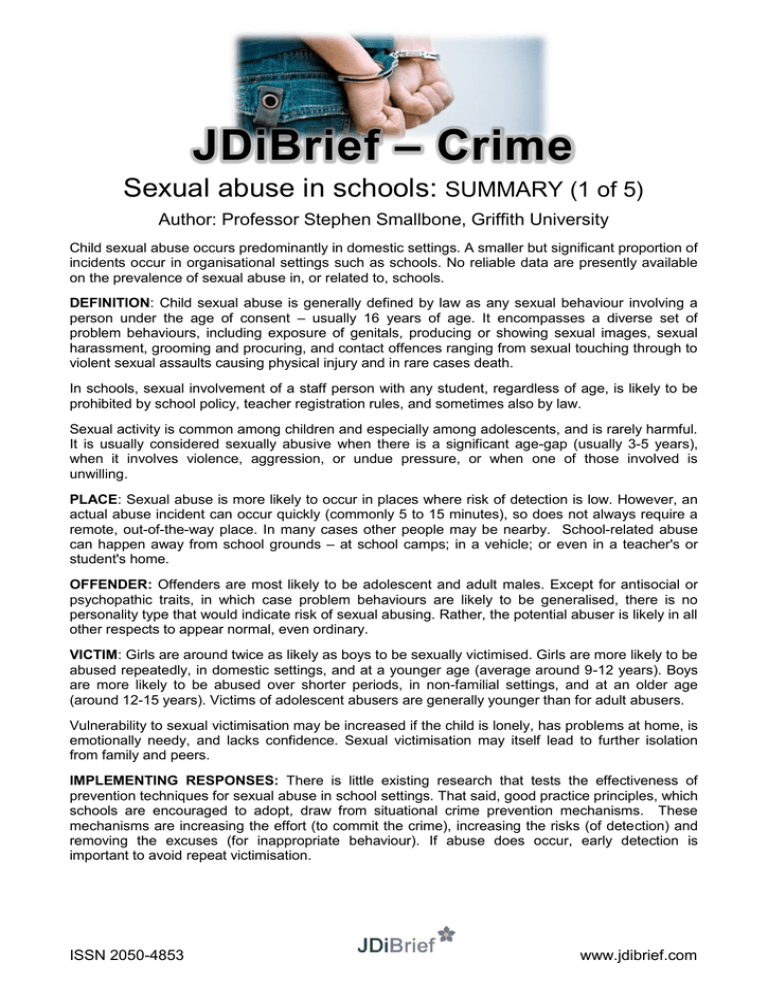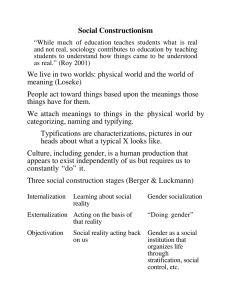– Crime JDiBrief Sexual abuse in schools:
advertisement

JDiBrief – Crime Sexual abuse in schools: SUMMARY (1 of 5) Author: Professor Stephen Smallbone, Griffith University Child sexual abuse occurs predominantly in domestic settings. A smaller but significant proportion of incidents occur in organisational settings such as schools. No reliable data are presently available on the prevalence of sexual abuse in, or related to, schools. DEFINITION: Child sexual abuse is generally defined by law as any sexual behaviour involving a person under the age of consent – usually 16 years of age. It encompasses a diverse set of problem behaviours, including exposure of genitals, producing or showing sexual images, sexual harassment, grooming and procuring, and contact offences ranging from sexual touching through to violent sexual assaults causing physical injury and in rare cases death. In schools, sexual involvement of a staff person with any student, regardless of age, is likely to be prohibited by school policy, teacher registration rules, and sometimes also by law. Sexual activity is common among children and especially among adolescents, and is rarely harmful. It is usually considered sexually abusive when there is a significant age-gap (usually 3-5 years), when it involves violence, aggression, or undue pressure, or when one of those involved is unwilling. PLACE: Sexual abuse is more likely to occur in places where risk of detection is low. However, an actual abuse incident can occur quickly (commonly 5 to 15 minutes), so does not always require a remote, out-of-the-way place. In many cases other people may be nearby. School-related abuse can happen away from school grounds – at school camps; in a vehicle; or even in a teacher's or student's home. OFFENDER: Offenders are most likely to be adolescent and adult males. Except for antisocial or psychopathic traits, in which case problem behaviours are likely to be generalised, there is no personality type that would indicate risk of sexual abusing. Rather, the potential abuser is likely in all other respects to appear normal, even ordinary. VICTIM: Girls are around twice as likely as boys to be sexually victimised. Girls are more likely to be abused repeatedly, in domestic settings, and at a younger age (average around 9-12 years). Boys are more likely to be abused over shorter periods, in non-familial settings, and at an older age (around 12-15 years). Victims of adolescent abusers are generally younger than for adult abusers. Vulnerability to sexual victimisation may be increased if the child is lonely, has problems at home, is emotionally needy, and lacks confidence. Sexual victimisation may itself lead to further isolation from family and peers. IMPLEMENTING RESPONSES: There is little existing research that tests the effectiveness of prevention techniques for sexual abuse in school settings. That said, good practice principles, which schools are encouraged to adopt, draw from situational crime prevention mechanisms. These mechanisms are increasing the effort (to commit the crime), increasing the risks (of detection) and removing the excuses (for inappropriate behaviour). If abuse does occur, early detection is important to avoid repeat victimisation. ISSN 2050-4853 www.jdibrief.com


